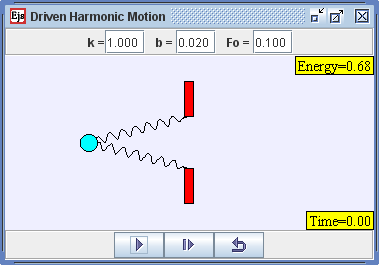
[Screen shot of Driven Harmonic Oscillator Model.]

[Screen shot of Driven Harmonic Oscillator Model.]
We continue our study of the numerical solution of ordinary differential equations by studying dynamical models that appear in upper-division physics classes. Although some of these models have simple analytic solutions, many do not. Studying and analyzing the EJS implementation of a models is, in fact, similar to doing a laboratory experiment and often provides us with a novel perspective on the behavior of the system.
This week's models also introduce new EJS drawing components and techniques.
Adding an external sinusoidal driving force to the Simple Harmonic Oscillator Model gives rise to the Driven Harmonic Oscillator model. If we include a viscous drag force (friction), the net force on the mass m is the sum of three forces.
Fnet = Fspring + Fdrag + Fexternal
where
Fspring = -k x, Fdrag = -b v, and Fexternal = FD sin ( ωD t ).
The spring constant k, the damping constant b, the drive amplitude FD, and the drive frequency ωD along with the initial conditions x(t=0) and v(t=0) are inputs into the model. Substituting the net force into Newton's Second Law gives the dynamical equation for the sinusoidally driven oscillator
d2x / dt2 = - (k/m)x - (b/m) dx / dt + (FD /m) sin ( ωD t ) .
Note that the angular drive frequency ωD in radians/time is not the natural angular frequency ω0 = (k/m)1/2 of the undriven simple harmonic motion.
The analytic solution to the differential equation is well know and consists of two parts known as the homogenous xH(t) and inhomogeneous xI(t) solutions. The complete solution x(t) is the sum of these solutions.
x(t) = xH(t) + xI(t)
The homogeneous or transient solution is the solution without a driving force and is a damped sinusoidal oscillation if the damping constant b is not too large.
xH(t) = A0 e-γt cos(ω1t + φ) = e-γt (C1 cos(ω1t) + C2 sin(ω1t))
where the decay constant gamma is γ = b/2m. The frequency of
oscillation
ω1 = (ω02 - γ2
)1/2 is less than without damping.
The homogenous solution will not be sinusoidal if b ≥ 4 m k. If b > 4 m k the system is over-damped and the solution is:
xH(t) = C1 e-pt + C2 e-qt
where the two decay constants are p = γ - (γ2 - ω02 )1/2 and q = γ + (γ2 - ω02)1/2.
If b = 4 m k the system is critically-damped and the solution is:
xH(t) = (C1 + C2 t) e-γt .
Set the drive amplitude FD to zero vary the damping constant b in order to observe sinusoidal and non-sinusoidal homogeneous solutions. o
The second part of the solution is known as the inhomogeneous or steady state solution. The inhomogeneous solution is a constant-amplitude sinusoidal function with frequency equal to the drive frequency ωD
xI(t) = A(ωD) cos(ωDt + θ) .
Although the amplitude is constant, its value A(ωD) depends on the drive frequency ωD and the physical parameters FD, k, m, and b. The phase shift θ between the external force and the steady state solution is also function of drive frequency and the physical parameters.
Set the drive amplitude FD to one and the drive frequency to 90% of the natural frequency of oscillation. Describe and explain the x(t) plot if the damping constant is zero. What happens if the damping constant is not zero? o
What happens to the oscillator displacement x(t) the when the oscillator is driven at its natural frequency ωD = ω0? o
The following dynamical models will be discussed in class.
Additional models may be be posted for self-study.
The Simple Pendulum Model was created by Wolfgang Christian using the Easy Java Simulations (EJS) version 4.1 authoring and modeling tool. You can examine and modify a compiled EJS model if you run the model (double click on the model's jar file), right-click within a plot, and select "Open Ejs Model" from the pop-up menu. You must, of course, have EJS installed on your computer.
Information about Ejs is available at: <http://www.um.es/fem/Ejs/> and in the OSP comPADRE collection <http://www.compadre.org/OSP/>.